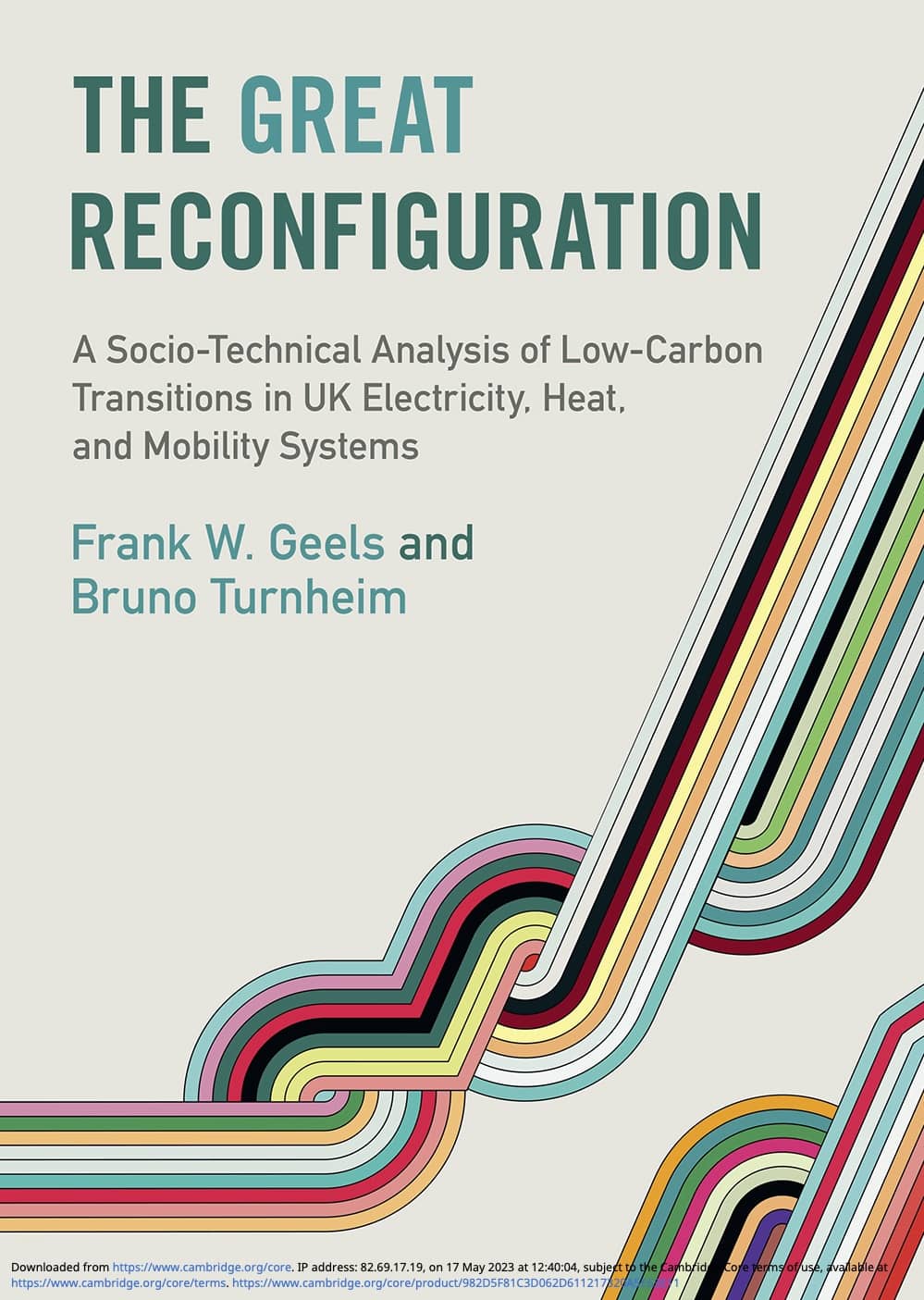
www.buildingsandcities.org/insights/reviews/the-great-reconfiguration.html
The Great Reconfiguration: A Socio-Technical Analysis of Low-Carbon Transitions in UK Electricity, Heat, and Mobility Systems
By Frank W. Geels and Bruno Turnheim. Cambridge University Press, 2022, ISBN: 9781009198240
William Throndsen applauds this book which advocates for socio-technical approaches to reconfigure low-carbon transitions of the electricity, heat and mobility energy sectors. The substantial overview and extensive examples provided make the book a relevant policy makers.

In the preface of The Great Reconfiguration, the authors mention that a growing sense of urgency acted as backdrop for the writing of this book as the Sixth Assessment Report by the Intergovernmental Panel on Climate Change (IPCC, 2021) was presented at the 2021 United Nations Climate Change Conference in Glasgow. Now, nearly a year and a half later, a sense of urgency is back again as another publication from the IPCC (IPCC, 2023) is marking the context of the writing of this review. But one might ask, is this ever-increasing and periodically recurring sense of urgency ever going to be addressed in a meaningful way? The effect of an increased sense of urgency seems to be a hardening of discourse where calls for action can sometimes morph into violent incidents. Such displays of frustration are understandable given the urgency combined with perceived (and real) inaction of industry actors and policy makers. However, such discord will likely cause further division and make us increasingly unable to foster the society-wide collaboration needed to safeguard against the worst consequences of climate change.
According to the authors, one main cause of the inability of our governments to present meaningful and feasible low-carbon transition pathways is due to the prevalence of integrated assessment models. Although useful, these draw mainly on economic and engineering knowledge and are too abstract and oversimplified. This approach overlooks social realities e.g. actor's beliefs and behaviours, as well as the workings of real-world policy making, institutions, and technology implementation processes. To remedy this, the authors create an analytical path towards transitions that are based not on narrow technical reform or grand but over-simplified roadmaps to revolution, but instead towards reconfiguration. Their stated goal is to transcend a 'stale dichotomy' of cool market liberalism on one hand versus dramatic and naïve ideological approaches to sustainability and climate discourse on the other.
This path of reconfiguration is a culmination of the authors' combined decades-long work within the extensive field of socio-technical transitions research. This is underpinned by the Multi-Level Perspective (MLP). The authors situate their book in contrasting continuation of the somewhat revolutionary oriented and very macro and longitudinal perspective of Polanyi's (1944) The Great Transformation: The Political and Economic Origins of Our Time. The goal here is to field MLP in a way that is more substantial in terms of scope and depth than what we are usually accustomed to (i.e. specific socio-technical conditions and landscapes).
The main empirical contribution of the book takes the form of three chapters, each providing a 'longitudinal multidecadal' analysis of the unfolding low-carbon transitions in the UK electricity, heat, and mobility systems respectively. The book also contributes a detailed overview of current MLP state-of-the-art, with relevant adjustments made for the current endeavour. This provides both a solid introduction to new readers as well as an update for intermediates. The studies and the cross-cutting analysis and conclusions at the end can probably be enjoyed separately, thus making it a suitable read for industry actors and policy makers looking for a comprehensive longitudinal analysis of the electricity, heat and mobility systems in the UK as well.
The book's conclusions give a comprehensive overview of the state of transition, in terms of progress of reconfiguration of the three energy sectors. The analysis is divided into scope and depth of techno-economic, actor, and policy reconfiguration. This provides a summary of each of the contributions made to the reconfiguration of each sector and lists them according to MLP terms. For example: niche-innovations, where novel technologies have entered into the mainstream (e.g. heat-pumps, EVs), or system substitution, where for instance a switch in fuel sources have been made (e.g. from coal to gas). Also indicated are the many niches, substitutions and improvements that are not fully exploited yet and where transformative potential remain, such as battery storage, retrofitting, or car sharing.
Cutting across the three sectors gives insights into the scope and depth of the reconfiguration of each sector. This provides a clear indication of each sector's achievements and remaining potential. In the electricity sector, the authors find that many of the transformative elements introduced have been in accordance with industry and policy incumbency. For example: large-scale wind and PV has been preferred to small-scale, smart grids have enabled flexibility but very little in terms of peer-to-peer trading and micro-grids, and flexibility markets still provide mostly large-scale backup rather than exploiting domestic demand side response. In other words, the scope is wide but the depth remains underemphasized so the sector's potential is underutilised. This finding is representative of most of the categories for mobility and heating as well. This means that low-hanging fruit in a mostly business-as-usual modus operandi seems to have been the norm thus far. Although it has produced some positive results, continuing along these lines may be coming close to exhausting most transformative potential. This suggests that both more industry initiative and stronger policy support are required. As the authors make clear, the carbon reduction potential of going beyond current achievements is unquestionably substantial. In sum, the Great Reconfiguration is still only beginning, the end point of which will elicit changes both high in scope and depth.
Rather than simply pointing out the prevalence of incumbency and lock-in mechanisms of vested interests, the authors provide a solid terminology for identifying and managing mechanisms that can increase momentum of emerging innovations and weaken system lock-ins in terms of techno-economic, actors, and policy. For instance, momentum-increasing examples include better technology or performance improvements (techno-economic); enrolling more and varied groups of actors; and changing policy strategies or implementing support structures. Weakening lock-in is represented by increasing cost or exploiting failure of incumbent technology where loss of legitimacy can cause actors to disband from industry networks, or changes in electoral politics or policy goals. Many examples are provided in the book. For instance, the momentum in the mobility sector of EVs was aided by falling costs of batteries and the 2016 Dieselgate (where car manufacturers were exposed for being less than truthful about vehicle emissions). Another example is the rapid modal shift from cars to other transport modes such as bus and cycling in London, driven by such mechanisms as political leadership and introduction of the Oyster Card (a digital payment system for the public transport system) in combination with weakened lock-in represented by the rising discontent caused by congestion and parking problems.
Implementing socio-technical transitions means change makers must always keep an eye on windows of opportunity. The Great Reconfiguration means change actors must learn to ride a wave of opportunity and failure in a timely fashion. Although the authors do not provide a recipe for success per se, they do give a very comprehensive overview of what does and does not work, as well as an exhaustive terminology for describing the mechanisms and actors involved. The strength of this approach lies in its consistent admission of setbacks as well as success, thus insisting on a symmetrical approach to the socio-technical phenomenon that is transition. Admitting that there will be setbacks also means that setbacks sometimes work in our favour.
It is incumbent upon responsible actors to exploit every opportunity that presents itself, as well as nurturing change where market liberal incentives simply do not. In an academic setting, the MLP still provides a useful taxonomy to describe and understand transitions, but perhaps its usefulness can be further exploited within the sphere of policy making and public discourse. As indicated in this review, we are in dire need of meaningful narratives of change that are as convincing about feasibility as they are truthful about setbacks. This could bridge the gap between the rational and the passionate, ultimately contributing to the possibility of a semblance of concerted effort at the eleventh hour.
References
IPCC. (2021). Climate Change 2021: The Physical Science Basis. Contribution of Working Group I to the Sixth Assessment Report of the Intergovernmental Panel on Climate Change [Masson-Delmotte, V., P. Zhai, A. Pirani, S.L. Connors, C. Péan, S. Berger, N. Caud, Y. Chen, L. Goldfarb, M.I. Gomis, M. Huang, K. Leitzell, E. Lonnoy, J.B.R. Matthews, T.K. Maycock, T. Waterfield, O. Yelekçi, R. Yu, and B. Zhou (eds.)]. Cambridge University Press, Cambridge, UK and New York, US. doi:10.1017/9781009157896.
IPCC. (2023). AR6 Synthesis Report: Climate Change 2023. https://www.ipcc.ch/report/ar6/syr/
Polanyi, Karl. (1944). The Great Transformation. Boston: Beacon Press.
Latest Peer-Reviewed Journal Content
A framework for 1.5°C-aligned GHG budgets in architecture
G Betti, I Spaar, D Bachmann, A Jerosch-Herold, E Kühner, R Yang, K Avhad & S Sinning
Net zero retrofit of the building stock [editorial]
D Godoy-Shimizu & P Steadman
Co-learning in living labs: nurturing civic agency and resilience
A Belfield
The importance of multi-roles and code-switching in living labs
H Noller & A Tarik
Researchers’ shifting roles in living labs for knowledge co-production
C-C Dobre & G Faldi
Increasing civic resilience in urban living labs: city authorities’ roles
E Alatalo, M Laine & M Kyrönviita
Co-curation as civic practice in community engagement
Z Li, M Sunikka-Blank, R Purohit & F Samuel
Preserving buildings: emission reductions from circular economy strategies in Austria
N Alaux, V Kulmer, J Vogel & A Passer
Urban living labs: relationality between institutions and local circularity
P Palo, M Adelfio, J Lundin & E Brandão
Living labs: epistemic modelling, temporariness and land value
J Clossick, T Khonsari & U Steven
Co-creating interventions to prevent mosquito-borne disease transmission in hospitals
O Sloan Wood, E Lupenza, D M Agnello, J B Knudsen, M Msellem, K L Schiøler & F Saleh
Circularity at the neighbourhood scale: co-creative living lab lessons
J Honsa, A Versele, T Van de Kerckhove & C Piccardo
Positive energy districts and energy communities: how living labs create value
E Malakhatka, O Shafqat, A Sandoff & L Thuvander
Built environment governance and professionalism: the end of laissez-faire (again)
S Foxell
Co-creating justice in housing energy transitions through energy living labs
D Ricci, C Leiwakabessy, S van Wieringen, P de Koning & T Konstantinou
HVAC characterisation of existing Canadian buildings for decarbonisation retrofit identification
J Adebisi & J J McArthur
Simulation and the building performance gap [editorial]
M Donn
Developing criteria for effective building-sector commitments in nationally determined contributions
P Graham, K McFarlane & M Taheri
Reimagining circularity: actions for optimising the use of existing buildings
R Lundgren, R Kyrö, S Toivonen & L Tähtinen
Effective interdisciplinary stakeholder engagement in net zero building design
S Vakeva-Baird, F Tahmasebi, JJ Williams & D Mumovic
Metrics for building component disassembly potential: a practical framework
H Järvelä, A Lehto, T Pirilä & M Kuittinen
The unfitness of dwellings: why spatial and conceptual boundaries matter
E Nisonen, D Milián Bernal & S Pelsmakers
Environmental variables and air quality: implications for planning and public health
H Itzhak-Ben-Shalom, T Saroglou, V Multanen, A Vanunu, A Karnieli, D Katoshevski, N Davidovitch & I A Meir
Exploring diverse drivers behind hybrid heating solutions
S Kilpeläinen, S Pelsmakers, R Castaño-Rosa & M-S Miettinen
Urban rooms and the expanded ecology of urban living labs
E Akbil & C Butterworth
Living with extreme heat: perceptions and experiences
L King & C Demski
A systemic decision-making model for energy retrofits
C Schünemann, M Dshemuchadse & S Scherbaum
Modelling site-specific outdoor temperature for buildings in urban environments
K Cebrat, J Narożny, M Baborska-Narożny & M Smektała
Understanding shading through home-use experience, measurement and modelling
M Baborska-Narożny, K Bandurski, & M Grudzińska
Building performance simulation for sensemaking in architectural pedagogy
M Bohm
Beyond the building: governance challenges in social housing retrofit
H Charles
Heat stress in social housing districts: tree cover–built form interaction
C Lopez-Ordoñez, E Garcia-Nevado, H Coch & M Morganti
An observational analysis of shade-related pedestrian activity
M Levenson, D Pearlmutter & O Aleksandrowicz
Learning to sail a building: a people-first approach to retrofit
B Bordass, R Pender, K Steele & A Graham
Market transformations: gas conversion as a blueprint for net zero retrofit
A Gillich
Resistance against zero-emission neighbourhood infrastructuring: key lessons from Norway
T Berker & R Woods
Megatrends and weak signals shaping future real estate
S Toivonen
A strategic niche management framework to scale deep energy retrofits
T H King & M Jemtrud
Generative AI: reconfiguring supervision and doctoral research
P Boyd & D Harding
Exploring interactions between shading and view using visual difference prediction
S Wasilewski & M Andersen
How urban green infrastructure contributes to carbon neutrality [briefing note]
R Hautamäki, L Kulmala, M Ariluoma & L Järvi
Implementing and operating net zero buildings in South Africa
R Terblanche, C May & J Steward
Quantifying inter-dwelling air exchanges during fan pressurisation tests
D Glew, F Thomas, D Miles-Shenton & J Parker
Western Asian and Northern African residential building stocks: archetype analysis
S Akin, A Eghbali, C Nwagwu & E Hertwich
Join Our Community

The most important part of any journal is our people – readers, authors, reviewers, editorial board members and editors. You are cordially invited to join our community by joining our mailing list. We send out occasional emails about the journal – calls for papers, special issues, events and more.
We will not share your email with third parties. Read more



Latest Commentaries
COP30 Report
Matti Kuittinen (Aalto University) reflects on his experience of attending the 2025 UN Conference of the Parties in Belém, Brazil. The roadmaps and commitments failed to deliver the objectives of the 2025 Paris Agreement. However, 2 countries - Japan and Senegal - announced they are creating roadmaps to decarbonise their buildings. An international group of government ministers put housing on the agenda - specifying the need for reduced carbon and energy use along with affordability, quality and climate resilience.
Building-Related Research: New Context, New Challenges
Raymond J. Cole (University of British Columbia) reflects on the key challenges raised in the 34 commissioned essays for Buildings & Cities 5th anniversary. Not only are key research issues identified, but the consequences of changing contexts for conducting research and tailoring its influence on society are highlighted as key areas of action.